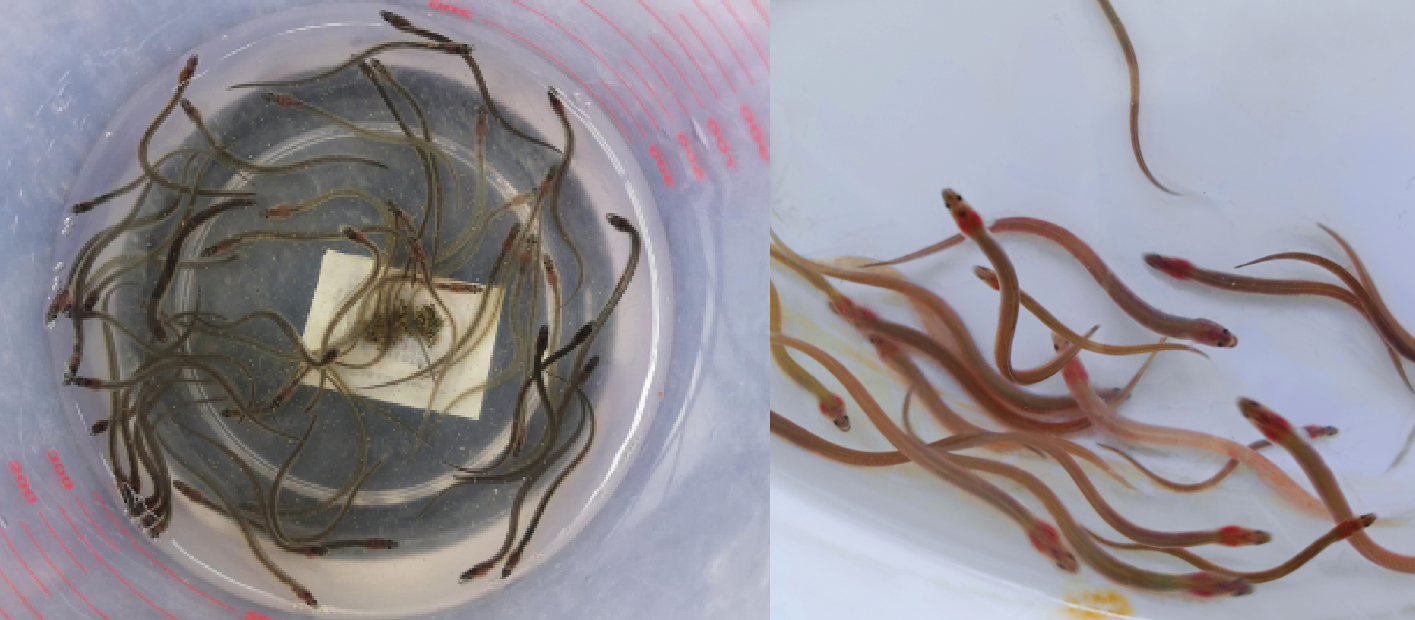
Feeding of glass eels with floating dough. (Image credit: UPV NEED-Project II Team)
Aiming to satisfy the dietary needs of growing glass eels, a floating eel feed was optimally developed by the University of the Philippines Visayas (UPV).
This developed feed decreases the reliance on feeding glass eels with live plankton feed and minced fish meat that can carry infectious pathogens and jeopardize the whole nursery culture operations.
As a product of an ongoing project, “Development of Brackishwater Nursery Culture Systems for Tropical Anguillid Eel Anguilla marmorata in the Philippines,” the floating glass eel feed was formulated using practical feed ingredients locally available in the Philippines to make it easily available for adoption and implementation by eel growers.
Funded by the Philippine Council for Agriculture, Aquatic and Natural Resources Research and Development of the Department of Science and Technology (DOST-PCAARRD), the project is being led by Mr. Fredson H. Huervana of the Institute of Aquaculture, College of Fisheries and Ocean Sciences at UPV.
Using floating glass eel feed is considered ideal in eel aquaculture as this feeding strategy allows visual assessment of eel’s health condition while feeding floating feeds at the surface. Sick and infected animals can be easily detected and collected, significantly avoiding mass outbreaks of diseases in the culture system.
According to the project team, anguillid eels global trading is a Billion US-dollar Industry and the Philippines is one of the major export suppliers of kuroko and marketable-size eels (250 grams and above) used in intensive aquaculture in the East Asian Countries. As the global demand for cultured anguillid eels increases, the fishing efforts for these juveniles are also rising, leading to the possible depletion of natural stocks.
As Fisheries Administrative Order 242 imposes new legal policies for exporting glass eels, allowing only 6-inch juvenile eels, the project seeks to develop nursery-rearing technologies to grow Philippine anguillid glass eels to the recommended juvenile size that could be used for its conservation and management.
Nursery-reared technology adoption is expected to result in attaining the legal juvenile size for export, thereby enabling its exportation. This leads to a significant source of income for the communities residing in coastal and estuarine areas.
The development of nursery-rearing technology for anguillid eels in the Philippines has been full of challenges and technological mishaps. This is because information on feeding habits, behavior, and physiology of these tropical anguillid eels, particularly Anguilla marmorata are scarce. The development of a formulated diet to grow glass eels to legal size has been the bottleneck in the development of a practical nursery production system for these tropical anguillid eels.
Floating eel feed development addresses the challenges associated with the suboptimal growth and survival rates of the eel species, A. marmorata and A. bicolor pacifica glass eels during the crucial nursery stage. The feeding trial test showed the efficacy of the developed feed, demonstrating comparable growth and survival rates for eel larvae to those fed solely with live feed.
Recently, the project has also attained another breakthrough in developing crumble feeds for the nursery rearing of A. marmorata. Utilization of floating pelleted feeds for eel nursery culture greatly simplifies the feeding protocols. The floating dough requires a good amount of time to mix and add the necessary ingredients including oil, binder, and water. The development of a floating pelleted dry feed for eel nursery culture simplifies the feeding protocols and is considered a significant leap in the culture of this highly priced Philippine anguillid eel.

Crumble diet for nursery rearing of A. marmorata. (Image credit: UPV NEED-Project II Team)
Rigorous tests are currently conducted to optimize feeding protocols using formulated dry crumble
diets. This feed development not only streamlines the feeding protocol in the early life stages of A. marmorata but also prepares the eel juvenile for the grow-out conditions.

Now on its second year of implementation, the project continuously focuses on the development of a brackishwater nursery system for A. marmorata, enhancing growth and survival through a combination of practical feed formulation and innovative feeding protocols. The technological outputs of this project can promote and stimulate the expansion of the production and industry outputs of tropical eel aquaculture in the Philippines.

